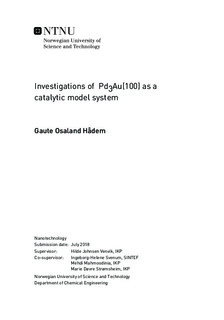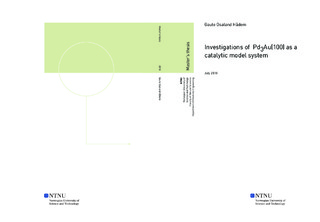| dc.description.abstract | Catalysts are defined as materials that lowers the activation energy of a reaction, without being consumed. In heterogeneous catalysis they are commonly transitions metals which have been refined to small particles using various methods and are embedded on a oxide support. Since heterogeneous catalysis is a surface phenomenon, one way of studying interaction between reactive gases and the catalysts is by employing single crystals of the same metal as a model system and study these under ultra-high vacuum conditions (UHV). This study aims at investigating the Pd3Au model system with orientation (100) to gain a better understanding of how the composition in the surface region changes with temperature and exposure to hydrogen and oxygen gas. It is crucial to predict and control the amount of palladium (Pd) and gold (Au) in the surface when Pd-Au systems are employed as catalysts for CO oxidation and used as a hydrogen permeable membrane.
Investigations were performed using both theoretical and experimental methods. First-principle calculations were performed using Density Functional Theory and experimental investigations involved x-ray photoelectron spectroscopy (XPS) with a fixed photon energy, high-resolution XPS with synchrotron radiation, low-energy electron diffraction (LEED) for determination of the average surface structure and local investigations on the surface were performed with scanning tunnelling microscopy (STM).
From first-principle calculations, various terminations of the Pd3Au(100) surface were calculated and the effect of carbon on the surface and in the subsurface determined. The most stable surface in vacuum was found to be Au terminated with a surface energy of 79.12 meV/Å2, while the least stable was the Pd terminated with a surface energy of 110.27 meV/Å2. The adsorption energy of carbon is found to increase with increasing Pd coverage. To determine the reason for this increase in adsorption energy, the d-band model proposed by Hammer and Nørskov \cite{Hammer1995} was employed and the calculated d band center shifts towards the Fermi level with an increasing amount of Pd adjacent to the adsorbed carbon, in agreement with the increasing adsorption energy. This is caused by Pd having d-band center closer to the Fermi level, making them more reactive.
Experimental investigations involved hydrogenation of the sample and through characterization by XPS it was revealed that at 300 oC, hydrogenation of residual carbon on the surface is occurring. This also coincided with the lowest amount of Au measured, which indicates that there is a preferential segregation of Pd to the surface under these conditions. Investigations with HRXPS after exposing the surface to large amounts of oxygen caused a preferential segregation of Pd to the surface with Au being found below the surface. Heating the sample to 200 oC causes desorption of oxygen found on the surface, but does not significantly cause migration of Au to the surface. Further heating to 300 \si{\celsius} causes segregation of Au to the surface, but there is still Pd in the topmost layer. Finally, heating to 500 \si{\celsius} causes the surface to become covered with Au and Pd is found in layers below. From valence band measurements obtained after annealing to 300 and 500 oC, the center of the band has a shift to higher energies with higher temperature, caused by more Au in the surface. This is in agreement with the calculations performed. Using the scanning tunnelling microscope (STM), it is found that the surface is highly stepped with many clusters on the surface after exposure to large amounts of oxygen. The origin of these clusters and what they are made of is still unclear.
Based on the findings in this report, the termination of the Pd_3 Au(100) was found to be important to control in order to have a reactive surface. H2 and O2 exposure at elevated temperatures caused more Pd to be found in the surface and the temperature range and pressure of the reactive gases is important to control in order to have reactive Pd sites in the surface. | |

